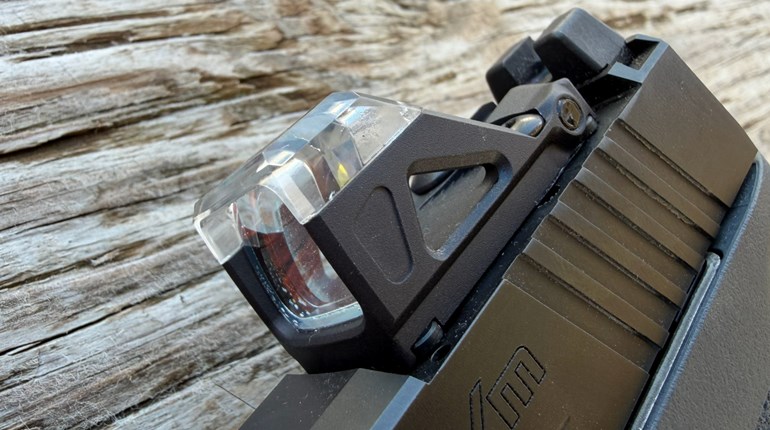
Mounting a red dot reflex sight directly to the slide of a semi-auto pistol has become extremely popular for both competition and personal defense. Having used slide-mounted red dots extensively I'm often asked, on competition ranges or at classes, “What's the best distance to sight in the red dot?”
That's not only a valid question, but an important one.
The red dot's sight axis sits noticeably higher above the bore axis than iron sights. Most slide-mounted reflex sights will position the dot 0.80 to 1.30-inches above the bore. That red-dot sight offset is similar (although not as extreme) to the sight/bore offset on an iron-sighted AR-15. That's a big factor when compared to the much lower iron handgun sights
In order for the bullet to impact on the dot (point-of-impact, or POI), the bore and sight axis have to intersect at some point. Since the bore axis is fixed, that means that the red-dot sight axis has to be adjusted to point downward to intersect with it to achieve the point-of-aim (POA). Once the sight axis is pointed downward to intersect with the bore axis it will continue downward along that line, while the bore axis continues on its fixed line.
What that means, for all practical purposes, is that regardless of the sight in distance chosen (intersection point) a red dot sight won't be “dead on” for all distances. Prior to the chosen intersection point, the sight axis will be above the bore axis and the POI will be lower than the sights. Beyond that point the sight axis will continue down and away from the bore axis, making the POI higher than the POA.
There is no way to sight a red dot-equipped handgun to be “dead on” at every distance. But, by choosing the right sight-in distance, a shooter can minimize the POI dispersion and have their sights acceptably close for any range within their conceivable needs. A recent test I conducted clearly shows that the chosen sight-in distance can make a significant difference.
For this test I used my five-inch barrel 9 mm Smith & Wesson M&P CORE and Trijicon SRO red dot sight with a 2.5 MOA dot. That sight puts the dot (sight axis) about 1.25-inches above the bore axis. I have fired thousands of rounds with this gun in competition. The ammunition used was Federal Premium's American Eagle 124 grain FMJ; an accurate load that approximates the ballistics of most 9 mm self-defense loads.
I set a sturdy sandbag rest on the 25-yard shooting bench on my backyard range and then, using a tape measure, marked 5 and 12-yard points forward of the bench. Two portable target frames were used: one holding multiple targets to allow zeroing the gun, and the other to hold a single final test target. The targets were 3-inch burst-type that would clearly show the bullet holes and placed on a white 8x10 sheet of white copy paper.
I started at 25 yards and confirmed the gun's zero. I then fired a three-round group on the test target and marked those holes in blue. That target was moved to 12 yards, and using the same 25-yard zero and center hold I fired another three-round group, marking those in black, I repeated that at 5 yards, marking them in red. There was less than two-inches of vertical dispersion among the nine-rounds at the three different ranges, and all within the three-inch target. I then moved the targets to 12 yards, re-zeroed the gun to that range, and fired a three-round group on the test target. The target was then moved to five-yards for a three-round group, and back to 25 yards for three rounds. With the sight axis dipped more downward the vertical dispersion among the groups increased. The total dispersion among the nine-rounds was 3.5 inches, with the 25-yard group about 2.25 inches above target center.
Five yards was next. The gun was re-zeroed for that range. That the five-round group was fired, With the same sight setting and center target hold, three-round groups were then fired at 12 and 25 yards. The same markings: blue for 25, black for 12, and red for 5 were used throughout this test.
With the sight axis dipped more radically-downward to that shorter range the dispersion increased dramatically. The 12-yard group center was 2.75 inches above POA and the 25-yard group was a whopping 5.80 inches high.
These tests were done with a sight axis 1.25 inches above the bore. Guns with a lower sight mounting distance will show slightly less dispersion. But, at shorter sight in distances noticeable dispersion will still exist. Simple geometry tells us that the longer the sight in distance chosen, the more gradual the downward sight axis will be, and the less dispersion will result.
A red dot sight will never be “dead on” at every range. But, those shooters who go through the effort to zero their sights at longer ranges will find that they're close enough at any range.



































